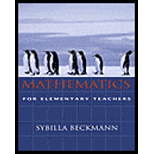Solutions for Mathematics For Elementary Teachers
Browse All Chapters of This Textbook
Book Details
1. Problem Solving.
Solving Problems.
Explaining Solutions.
2. Numbers and the Decimal System.
Introduction to the Number Systems.
The Decimal System and Place Value.
Representing Decimal Numbers.
Comparing Sizes of Decimal Numbers.
Rounding Decimal Numbers.
3. Fractions.
The Meaning of Fractions.
Equivalent Fractions.
Fractions as Numbers.
Comparing Sizes of Fractions.
Percent.
4. Addition and Subtraction.
Interpretations of Addition and Subtraction.
The Algorithms for Adding and Subtracting.
Adding and Subtracting Fractions.
When Do We Add Percentages?
Percent Increase and Percent Decrease.
The Commutative and Associative Properties and Mental Math.
5. Multiplication.
The Meaning of Multiplication.
Why Multiplying Decimal Numbers by 10 IsEasy.
Multiplication and Areas of Rectangles.
The Commutative Property of Multiplication.
Multiplication and Volumes of Boxes.
The Associative Property of Multiplication.
The Distributive Property.
Mental Math, Properties of Arithmetic, and Algebra.
Why the Procedure for Multiplying Works.
6. Multiplication of Fractions, Decimals, and Negative Numbers.
Multiplying Fractions.
Powers.
Multiplying Decimals.
Multiplying Negative Numbers.
Scientific Notation.
7. Division.
The Meaning of Division.
Understanding Long Division.
Fractions and Division.
Dividing Fractions.
Dividing Decimals.
Ratio and Proportion.
8. Geometry.
Visualization.
Angles.
Circles and Spheres.
Triangles.
Quadrilaterals and Other Polygons.
Constructions With Straightedge and Compass.
Polyhedra and Other Solid Shapes.
9. Geometry of Motion and Change.
Reflections, Translations, and Rotations.
Symmetry.
Congruence.
Similarity.
10. Measurement.
The Concept of Measurement.
Error and Accuracy in Measurements.
Length, Area, Volume, and Dimension.
Calculating Perimeter, Area, and Volume.
Comparing Sizes of Objects.
Converting From one Unit of Measurement to Another.
11. More About Area and Volume.
The Moving and Combining Principles About Area.
The Pythagorean Theorem.
Approximating Areas of Irregular Shapes.
Cavalieri's Principle About Shearing and Area.
Areas of Triangles.
Areas of Parallelograms.
Areas of Circles and the Number Pi.
Relating the Perimeter and Area of a Shape.
Principles for Determining Volumes.
Volumes of Solid Shapes.
Areas, Volumes, and Scaling.
12. Number Theory.
Factors and Multiples.
Greatest Common Factor and Least Common Multiple.
Prime Numbers.
Even and Odd.
Divisibility Tests.
Rational and Irrational Numbers.
13. Functions and Algebra.
Mathematical Expressions, Formulas, and Equations.
Solving Equations With Pictures and With Algebra.
Sequences.
Series.
Functions.
Linear Functions.
14. Statistics.
Designing Investigations and Gathering Data.
Displaying Data and Interpreting Data Displays.
The Center of Data: Mean, Median and Mode.
The Spread of Data: Percentiles.
15. Probability.
Basic Principles and Calculation Methods of Probability.
Calculating Probabilities by considering the Ideal Outcome.
Sample Solutions for this Textbook
We offer sample solutions for Mathematics For Elementary Teachers homework problems. See examples below:
More Editions of This Book
Corresponding editions of this textbook are also available below:
